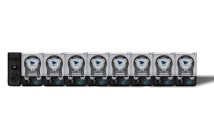
Don't be scared by the big equation. It's all just for show. But we think we have a fun and interesting way to calculate aquarium addiction. Continue reading below to find out.
Let’s face it, we’re all borderline aquarium addicts here. We stuff our homes full of fish tanks, visit the local fish store at least three or four times a week, and are constantly distracted from work and family life because we can’t stop thinking about ways to improve our aquariums. But in a world where everyone seems to want to one-up each other with over the top aquarium builds and tossing a pile of cash at expensive gear and rare livestock, how do we go about measuring the intensity of one’s addiction? Should we count the number of hours each person spends working on their tanks? Is money any indicator? While both of those are great parameters to judge one’s lucidity, we have another in mind. We feel a good way to measure one’s aquarium addiction is to mathematically compare the total amount of space the aquarium(s) is taking up compared to the total amount of livable space in the home. Basically, we are basing the addiction on how much of it you live in every day.
What got us started on this idea was a brief conversation with a local aquarium buddy. We were swapping stories of our favorite tanks in the area, trying to outdo each other at every turn. One individual that we heard of had a total of nine large aquariums, each over 100 gallons in volume, and all of them inside his home. Obviously that put to shame anything we’ve ever owned, and it got us thinking about others who virtually live out of their aquariums and deserve a spot on one of those hoarding shows.
Shortly after college, I spent a year in a small, single bedroom apartment while wading through the not-so-promising job market. During that time, I got my hands on a top of the line 180 gallon tank from a friend who was taking a break from the hobby. My wife thought I was totally nuts, but we managed to squeeze the monster into the tiny 600 square foot apartment. Obviously this tank took up a significant portion of space, but that didn’t stop me from also adding a 24 gallon Nano Cube and a small counter top pico tank to the mix as well. The combined overall footprint from each aquariums was an estimated 18 square feet. This comes out to being only 3% of the total livable space in the apartment, which doesn’t seem like a whole lot, but there was little wiggle room in the tiny place we called home. This led many people to second guess my judgement, but what can I say, I’m an addict.
Taking this example and applying it to other situations, it might be a good way to judge how addicted you and your friends are. The calculation is nowhere near as complicated at the top of the page, fortunately. Instead, it’s just a simple percentage. We wanted to calculate the total percent of space taken up by the aquarium. Again, really simple. Just take the total number of square feet in the home (hereafter called “A”), subtract the total number of square feet taken up by the aquarium (now called “B”), divide that difference by “A”, then multiply by 100 to get a percentage of living space not used for aquarium purposes (referred to as “C”). To find out the percentage of space taken up by the aquarium, simply subtract “C” from 100% to get the total % of space taken up by aquariums (let’s call it “D” just for fun). The formula should read like this: D = 100% – (((A-B)/A) * 100). It’s plainly obvious that I’m not a mathematician, so please don’t skewer me with your comments.
If we apply this formula to an average situation, say a 1500 square foot house with a standard sized 90 gallon aquarium (48 x 19 footprint), we get a total aquarium space of less than 0.4%. That’s nothing compared to the situation above where a 180 gallon tank was housed in a tiny apartment. So who’s the bigger addict?
We do realize there is a flaw in the ideology. We thought this out as a way to mathematically show how addicted individuals with tons of aquariums in their home were. However, a small aquarium in a very tiny living space will appear to show that one is more addicted than someone with a massive aquarium in a giant house. Obviously the larger tank would require a greater investment of both time and energy, so maybe we need to have a far more complex formula that encompasses monetary investment, time investment, living space vs aquarium space, and maybe even time spent away from work in tank emergency situations. But it’s all for fun anyways.







Pingback: Reef Threads Podcast #69 | Reef Threads()
Pingback: The AquaNerd Weekly Recap | AquaNerd()